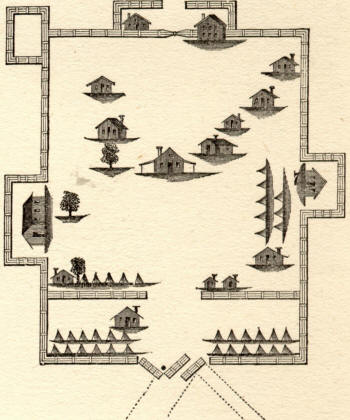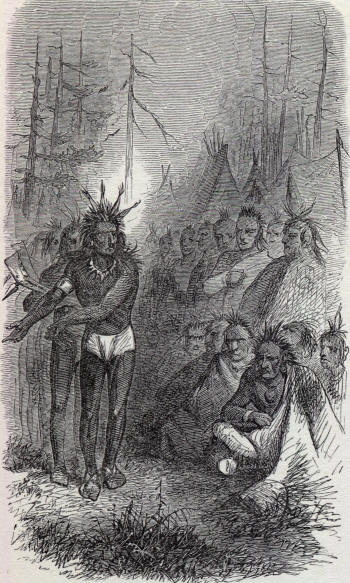|
Creek Indians,
members of a noted confederacy whose domain extended from the Atlantic
westward to the high lands which separate the waters of the Alabama and
Tombigbee rivers, including a greater portion of the States of Alabama
and Georgia and the whole of
Florida. It
was with the people of this confederacy that
Oglethorpe held his first
interview with the natives on the site of Savannah. They called
themselves Muscogees, but, the domain abounding in creeks, it was called
the Creek country by the Europeans. Evidently the kindred in origin and
language of the Chickasaws and Choctaws, they claimed to have sprung
from the earth, emigrated from the Northwest, and reached Florida, when
they fell back to the more fertile regions of the Ocmulgee, Coosa, and
Tallapoosa rivers. Some of them remained in Florida, and these became
the Seminoles of a later period.
De Soto penetrated their country as
early as 1540, and twenty years later De Luna formed an alliance with
the tribe of the Coosas. When the Carolinas and Louisiana began to be
settled by the English, Spaniards, and French, they all courted the
Creek nation. The English won the Lower Creeks, the French the Upper
Creeks, while the Spaniards, through their presents, gained an influence
over a portion of them. In 1710 some of these (the Cowetas) made war on
the Carolinas, and were petted by the Spaniards at St. Augustine, but in
1718 they joined the French, who built a fort at Mobile. In 1732 eight
Creek tribes made a treaty with
Oglethorpe at Savannah; and in 1739 he
made a treaty with the Cowetas, and they joined him in his expedition
against St. Augustine.
 When
the French power in North America was overthrown, the entire Creek
nation became subject to English influence. At that time they had fifty
towns, and numbered nearly 6,000 warriors. They were the allies of the
British during the American Revolution. Many Tories fled to the Creek
towns from the Carolinas and Georgia at the close of the war, and
excited the Indians to ravage the frontiers of those States. A peace was
concluded with the Creeks by Washington in 1790; yet some of them joined
the
Cherokees in incursions into Tennessee in 1792. Another treaty was
made in 1796, and in 1802 they began to cede lands in the United States.
But when the War of 1812 broke out they joined their old friends, the
English; and by an awful massacre at Fort Mims, in August, 1813, they
aroused the Western people to vengeance. Troops led by General Jackson
and others entered the Creek country; and in 1813 they ravaged the
finest portion of it, destroyed the towns, slew or captured 2,000 Creek
warriors, thoroughly subdued them, and, in fact, destroyed the nation.
Their last stand against the United States troops was made at Horseshoe
Bend in March, 1814. Some of them had already settled in Louisiana, and
finally in Texas, where they remained until 1872, when the government
took steps to reunite the nation in the
Indian Territory. They had ceded all their lands east of the
Mississippi. With those who had removed there was trouble at times. Some
favored removal west of the Mississippi; others opposed it. In 1825 they
put one of their chiefs (William McIntosh) to death for signing a treaty
for the cession of lands. When
the French power in North America was overthrown, the entire Creek
nation became subject to English influence. At that time they had fifty
towns, and numbered nearly 6,000 warriors. They were the allies of the
British during the American Revolution. Many Tories fled to the Creek
towns from the Carolinas and Georgia at the close of the war, and
excited the Indians to ravage the frontiers of those States. A peace was
concluded with the Creeks by Washington in 1790; yet some of them joined
the
Cherokees in incursions into Tennessee in 1792. Another treaty was
made in 1796, and in 1802 they began to cede lands in the United States.
But when the War of 1812 broke out they joined their old friends, the
English; and by an awful massacre at Fort Mims, in August, 1813, they
aroused the Western people to vengeance. Troops led by General Jackson
and others entered the Creek country; and in 1813 they ravaged the
finest portion of it, destroyed the towns, slew or captured 2,000 Creek
warriors, thoroughly subdued them, and, in fact, destroyed the nation.
Their last stand against the United States troops was made at Horseshoe
Bend in March, 1814. Some of them had already settled in Louisiana, and
finally in Texas, where they remained until 1872, when the government
took steps to reunite the nation in the
Indian Territory. They had ceded all their lands east of the
Mississippi. With those who had removed there was trouble at times. Some
favored removal west of the Mississippi; others opposed it. In 1825 they
put one of their chiefs (William McIntosh) to death for signing a treaty
for the cession of lands.
 In
1836 some of the Creeks joined their kindred, the Seminoles, in Florida
in attacks upon the white people, and others joined the United States
troops against them (the SEMINOLE WAR). They were finally nearly all
removed beyond the Mississippi, where they numbered about 25,000 in
1876. Unsuccessful attempts to Christianize them were made. They refused
missions and schools for a long time. Their nation declined, and in 1857
numbered less than 15,000. During the
Civil War the tribe was
divided in sentiment, 6,000 of them joining the Confederates. Their
alliance with the Confederates was disastrous to their nation. In 1866
they ceded 3,000,000 acres of their domain in the Indian Territory to
the United States for 30 cents an acre. In 1899 there were 14,771 Creeks
at the Union agency in Indian Territory. In
1836 some of the Creeks joined their kindred, the Seminoles, in Florida
in attacks upon the white people, and others joined the United States
troops against them (the SEMINOLE WAR). They were finally nearly all
removed beyond the Mississippi, where they numbered about 25,000 in
1876. Unsuccessful attempts to Christianize them were made. They refused
missions and schools for a long time. Their nation declined, and in 1857
numbered less than 15,000. During the
Civil War the tribe was
divided in sentiment, 6,000 of them joining the Confederates. Their
alliance with the Confederates was disastrous to their nation. In 1866
they ceded 3,000,000 acres of their domain in the Indian Territory to
the United States for 30 cents an acre. In 1899 there were 14,771 Creeks
at the Union agency in Indian Territory.
The men of the Creek Confederacy were
well-proportioned, active, and graceful; the women were smaller,
exquisitely formed, and some of them were very beautiful. In summer both
sexes went without clothing, excepting a drapery of Spanish moss that
was fastened at the waist and fell to the thighs. The principal people
painted their faces and bodies in fanciful colors, and fops sometimes
appeared in beautiful mantles of feathers or deer-skins, and on their
heads were lofty plumes of the eagle and the flamingo. The houses of the
chiefs stood upon mounds, sometimes in the form of a great pavilion, and
the inside of their winter dwellings were daubed with clay. Hunting,
fishing, and cultivating their fertile lands were their employment for
they seldom made aggressive war. They were skilful artisans in making
arms, houses, barges, canoes, and various ornaments. They made pottery
for kitchen service, and some of it was very ornamental. Fortifications
were constructed with moats, and walled towns and grand and beautiful
temples abounded. They made mats of split cane, with which they covered
their houses and upon which they sat. These resembled the rush carpeting
of the Moors. In their temples, dedicated to the worship of the sun,
were votive offerings of pearls and rich furs. They regarded the sun as
the superior deity, and in all their invocations they appealed to it as
to God. To it they made sacrifices of grain and animals. The chief,
while he was alive, was held in the greatest veneration as priest and
king. As a symbol of devotion to him of the entire strength of the
nation, the sacrifice of the first-born male child was required, while
the young mother was compelled to witness the slaughter of her child.
Their marriages were attended with great displays of ornaments and
flowers, and at the setting of the sun the bride and groom and their
friends prostrated them-selves before that luminary and implored his
blessing. Like the Iroquois, the civil power in their government was
widely distributed; and, like the Iroquois, the Creeks were an
exception, in their approach to civilization, to all the Indian tribes
of North America. Such were the Creek (or Muscogee) Indians when first
seen by Europeans. |